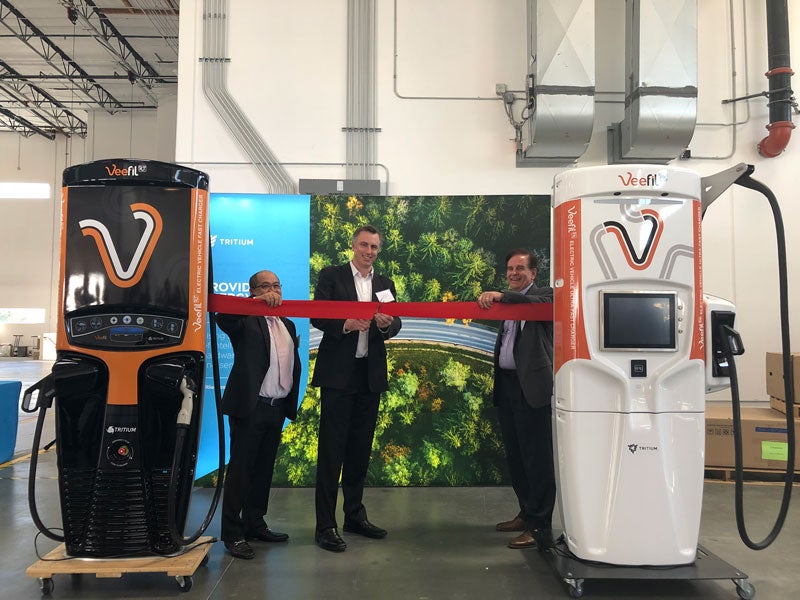Brisbane-based Tritium has quickly become a world leader in electric vehicle (EV) DC fast charging technology as it expands operations in both Europe and the United States (U.S).
Last month Tritium expanded its European operations, the company’s biggest market so far, with the establishment of its Tritium E-Mobility Innovation Centre in Amsterdam. From this establishment, Tritium has announced a series of expansive deals including:
- The addition of 120 more sites to an existing deal Tritium had with Ionity which will see up to six of Tritium’s flagship Veefil PK 350 kW DC High Power Chargers (HPCs) per site. This brings the overall deal to be inclusive of 400 planned sites across Europe.
- A deal to supply Veefil RT 50 kW DC Fast Chargers (DCFCs) to new British EV network entrant Drive Energi’s planned 2,500 sites throughout the U.K.
- A deal to supply Ireland’s first privately-owned charging network with DCFCs for up to 88 sites across the Emerald Isle.
The rapid expansion has brought upon the appointment of Manuel Fernandes as President of Tritium Europe. Tritium CEO and co-founder David Finn noted that “Europe has been a very strong market for Tritium, with the Ionity partnership and our large installation base throughout the Nordics and the UK. Given Manuel’s contribution to our success here, he is the natural choice to lead Tritium’s future growth across the continent.”
“The market is maturing across Europe and we are seeing an increase in interest in electric vehicle charging infrastructure,” said Fernandes. “This year we opened the Tritium E-Mobility Innovation Centre in Amsterdam to cater to this growth, and we will continue to add to our team to meet the market while continually innovating to stay ahead of it.”
Across the Atlantic in North America Tritium opened the doors of a new facility in Los Angeles in September after rapidly outgrowing its previous facility in Torrance. The Tritium E-Mobility Innovation Centre in Los Angeles will serve as the company’s headquarters in the Americas as it looks to increase production and cater to a rapidly growing sales pipeline.
The Los Angeles facility also features a testing facility to allow U.S. automotive manufactures to test vehicles for DC charging compatibility across Tritium’s range. The facility also boasts of a customer-focused R&D wing enabling the company to cater to customised requests.
“We outgrew our previous facility in Torrance faster than we ever expected, which is a testament not only to the team we have and the technology we can produce, but also to the growing demand for electric vehicle infrastructure in the United States and in particular California,” said Jeff Wolfe, President, Americas, Tritium.
The move is clearly working considering Tritium is already seeing its chargers installed across the country on the East coast at Boston’s Logan airport. The installation was made by British-Dutch oil giant Shell’s Shell Recharge brand which used Tritium chargers through the provider Greenlots. The occasion was shared on LinkedIn by Shell electric mobility manager Steve Bean.
The take-up of EVs is hindered by two entangled issues, the range anxiety of EVs themselves, and the dearth of charging stations. Tritium’s flexible, high-powered DC chargers are rapidly bringing the latter issue to a resolution (at least in urban areas). The Australian company’s rapid global expansion proves that the world is ready for the EV transition, it is only waiting for the technology and availability to catch up with the latent demand.
This content is protected by copyright and may not be reused. If you want to cooperate with us and would like to reuse some of our content, please contact: editors@pv-magazine.com.









1 comment
By submitting this form you agree to pv magazine using your data for the purposes of publishing your comment.
Your personal data will only be disclosed or otherwise transmitted to third parties for the purposes of spam filtering or if this is necessary for technical maintenance of the website. Any other transfer to third parties will not take place unless this is justified on the basis of applicable data protection regulations or if pv magazine is legally obliged to do so.
You may revoke this consent at any time with effect for the future, in which case your personal data will be deleted immediately. Otherwise, your data will be deleted if pv magazine has processed your request or the purpose of data storage is fulfilled.
Further information on data privacy can be found in our Data Protection Policy.